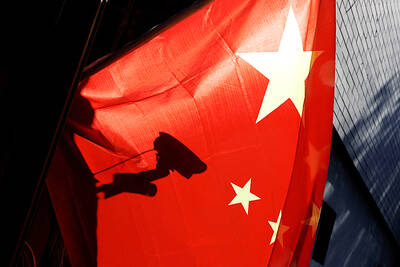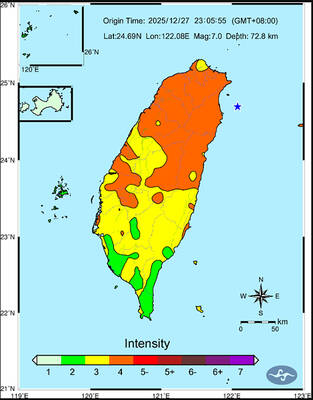The Ministry of National Defense (MND) said yesterday that any hope of implementing cross-strait military confidence-building measures were being hampered by China's refusal to withdraw or destroy missiles aimed at Taiwan.
“This issue is complicated,” Vice Admiral Lee Hsi-ming, director of the ministry's Military Strategy Planning Department, told a press conference in Taipei to mark the release of its biennial defense policy paper.
The removal of the missiles and confidence-building measures are key parts of President Ma Ying-jeou's (馬英九) cross-strait strategy for improving relations with a view to eventually signing a peace agreement.
Asked whether Taiwan has started talking with China on the establishment of such a mechanism, he said: “There is no timetable yet.”
However, the military has been conducting studies and surveys in this area to prepare for future talks, he said, including establishing a hot line between Taipei and Beijing and signing a pact to limit the deployment of military personnel and equipment against each other.
“We have not been able to make progress because China has not given up ... the notion of using force against Taiwan,” the ministry said, adding that China had continued to hold exercises aimed at preparing its troops to invade Taiwan.
“China has increased the frequency of its military exercises to pressure us since October 2008, when the US government announced the sale of an arms package to us,” the report said.
China has deployed at least 1,300 missiles at coastal military bases targeting Taiwan, “including short-range ballistic and cruise missiles ... by the Communist forces at their Nanjing and Guangzhou military bases,” it added.
Asked whether the ministry was up to date on the exact number of Chinese missiles, Intelligence Department Deputy Director Kao Chung-bang (高中邦) said it was classified information.
“The MND is fully aware of the latest situation, but we cannot make detailed information public,” Kao said.
Kao said Chinese missiles were also a major threat and concern for the US and Japan as the Chinese military continued to upgrade and develop new ones.
The Chinese air force also has more than 700 fighters based within 1,000km of Taiwan, the report said.
It said some of the fighters are equipped with airborne refueling facilities that can be used to extend their combat duration.
China's navy has been boosted by the introduction of nuclear-powered attack submarines and major combat vehicles armed with medium-range ballistic missiles capable of striking moving targets at sea.
“The purpose is to deter or delay foreign aircraft carriers coming to the rescue of Taiwan should war break out in the Strait,” it said.
While the report did not identify this “foreign force,” the only nation likely to send carriers to Taiwan in a war scenario is the US.
Meanwhile, the ministry denied a report by the military periodical Defense News that a submarine procurement team based in Washington could be disbanded as chances of Taiwan procuring submarines has diminished.
“I hereby clarify that the team remains functional and we have no intention of disbanding it anytime soon,” ministry spokesman Major General Yu Sy-tue (虞思祖) said.

A magnitude 7.0 earthquake struck off Yilan at 11:05pm yesterday, the Central Weather Administration (CWA) said. The epicenter was located at sea, about 32.3km east of Yilan County Hall, at a depth of 72.8km, CWA data showed There were no immediate reports of damage. The intensity of the quake, which gauges the actual effect of a seismic event, measured 4 in Yilan County area on Taiwan’s seven-tier intensity scale, the data showed. It measured 4 in other parts of eastern, northern and central Taiwan as well as Tainan, and 3 in Kaohsiung and Pingtung County, and 2 in Lienchiang and Penghu counties and 1

FOREIGN INTERFERENCE: Beijing would likely intensify public opinion warfare in next year’s local elections to prevent Lai from getting re-elected, the ‘Yomiuri Shimbun’ said Internal documents from a Chinese artificial intelligence (AI) company indicated that China has been using the technology to intervene in foreign elections, including propaganda targeting Taiwan’s local elections next year and presidential elections in 2028, a Japanese newspaper reported yesterday. The Institute of National Security of Vanderbilt University obtained nearly 400 pages of documents from GoLaxy, a company with ties to the Chinese government, and found evidence that it had apparently deployed sophisticated, AI-driven propaganda campaigns in Hong Kong and Taiwan to shape public opinion, the Yomiuri Shimbun reported. GoLaxy provides insights, situation analysis and public opinion-shaping technology by conducting network surveillance

Taiwan is gearing up to celebrate the New Year at events across the country, headlined by the annual countdown and Taipei 101 fireworks display at midnight. Many of the events are to be livesteamed online. See below for lineups and links: Taipei Taipei’s New Year’s Party 2026 is to begin at 7pm and run until 1am, with the theme “Sailing to the Future.” South Korean girl group KARA is headlining the concert at Taipei City Hall Plaza, with additional performances by Amber An (安心亞), Nick Chou (周湯豪), hip-hop trio Nine One One (玖壹壹), Bii (畢書盡), girl group Genblue (幻藍小熊) and more. The festivities are to

AFTERMATH: The Taipei City Government said it received 39 minor incident reports including gas leaks, water leaks and outages, and a damaged traffic signal A magnitude 7.0 earthquake struck off Taiwan’s northeastern coast late on Saturday, producing only two major aftershocks as of yesterday noon, the Central Weather Administration (CWA) said. The limited aftershocks contrast with last year’s major earthquake in Hualien County, as Saturday’s earthquake occurred at a greater depth in a subduction zone. Saturday’s earthquake struck at 11:05pm, with its hypocenter about 32.3km east of Yilan County Hall, at a depth of 72.8km. Shaking was felt in 17 administrative regions north of Tainan and in eastern Taiwan, reaching intensity level 4 on Taiwan’s seven-tier seismic scale, the CWA said. In Hualien, the